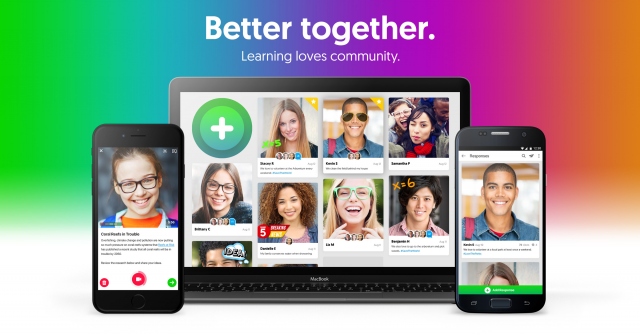
FlipGrid is a free online application that allows proposing activities in which the answers are in short videos easy to make up to 5 minutes that can be seen by others. It is social learning. It can be used in class or in other environments (groups of friends to organize something, professional environments, etc.), the key being that the results are short and easy videos to be made by the users themselves, both from the web and from the app for Android and iOS (iPhone, iPad, iPod touch).
The teacher can record himself on video to launch a question to his students, choose a video already made an image or simply write the question. Students can participate by contributing their answers to the question and interact by recording their own videos. From this idea the tool offers a multitude of possibilities for use inside and outside the classroom and makes it an ideal tool for flipped learning.
What is FlipGrid?
FlipGrid is a website in which the teacher or organizer of the activity is registered and creates and generates a code that sends students or those who are going to intervene in it very easily. All this will be seen step by step later in the article on how to use FlipGrid. Those who will intervene in that class or activity , receive that code or web address and can be recorded on video to give an oral and visual response , which can then add emojis (smiley faces and other fun decorations) and other features that young students can be attractive (perhaps to a more adult audience not so much).
The potential that has FlipGrid as a tool is of enormous value but it has a cost 0 as it is totally free because it is owned by Microsoft (before the full version was paid although they also had a more limited free version). It is true that in the beginning it can generate a certain distrust on the part of the students because they feel embarrassed to record on video, but in subjects that last several months and as they use it they lose that shame especially when they see that others use it and of course they do not publicly disseminated, remaining only as an academic activity rather than “is fun.” You can even make everyone learn from everyone, that is why it is sometimes called “social learning” and even “social e-learning”.
FlipGrid, although initially designed for classroom activity, can also be used in other environments and for other purposes such as:
- Establish contact with other people all over the world through the Internet with which certain interests are shared, for example to make lists of questions and answers (answered in video) by specialists in their field, reading clubs, for mentoring, etc.;
- For use by families to hold meetings with parents by teachers, so that parents with little free time can tell students what they are working on (a “show and tell” style they organize in other countries), to send a happy birthday message to someone from friends or relatives spread out in different locations, etc.;
- To comment on good practices among professors, to tell success stories of tools that work well among teachers, give opinions, etc.;
- In the case of educational centres it can also be used as a tool for students (for example in online training courses) to introduce themselves to their colleagues, to create yearbooks, to give news about schools, to meet the staff of the organization etc.;
- Made to measure: the potential of the tool is very large and can also be used for other specific uses that you want to take for granted;
- It is possible to come to think that by using other tools than FlipGrid you can do this and it is totally true;
- You can ask face to face, for WhatsApp (for example it would be a good idea for a group of WhatsApp in certain environments), email, Twitter, etc. to students or co-workers, for example, to videotape by answering a certain question or commenting on something;
- At the end each person is recorded as you can, sends the video in a format that is not always compatible with others (videos that are not seen on the iPad or on an Android for example), which weighs too much (you have to send by Dropbox or WeTransfer) and then, if you want to share with others, you need to upload them to YouTube, Vimeo, etc. with the consequent work and dedication;
- FlipGrid allows you to perform all these activities in one place through the web or an app for Android, iOS (iPhone, iPad and iPod touch) and greatly facilitates the task to all parties, both the one that launches it and the one that must respond;
- On Twitter with the hashtag #FlipGridForever you can see what users share and comment on the tool. Get Information at Essay Yard





